Michigan is home to some of the Midwest’s largest cities. The state has a lot to offer by way of financial growth and cultural centers. Today, we are going to explore the largest cities in Michigan by population, total area, and economic impact. We will look at each city’s demographics, geography, and economy. Next, we’ll look at their attractions, landmarks, and events that make them stand out. Whether you are a resident or a visitor, let’s discover something new and interesting about the largest cities in Michigan!

The Largest Cities in Michigan by Population
1. Detroit
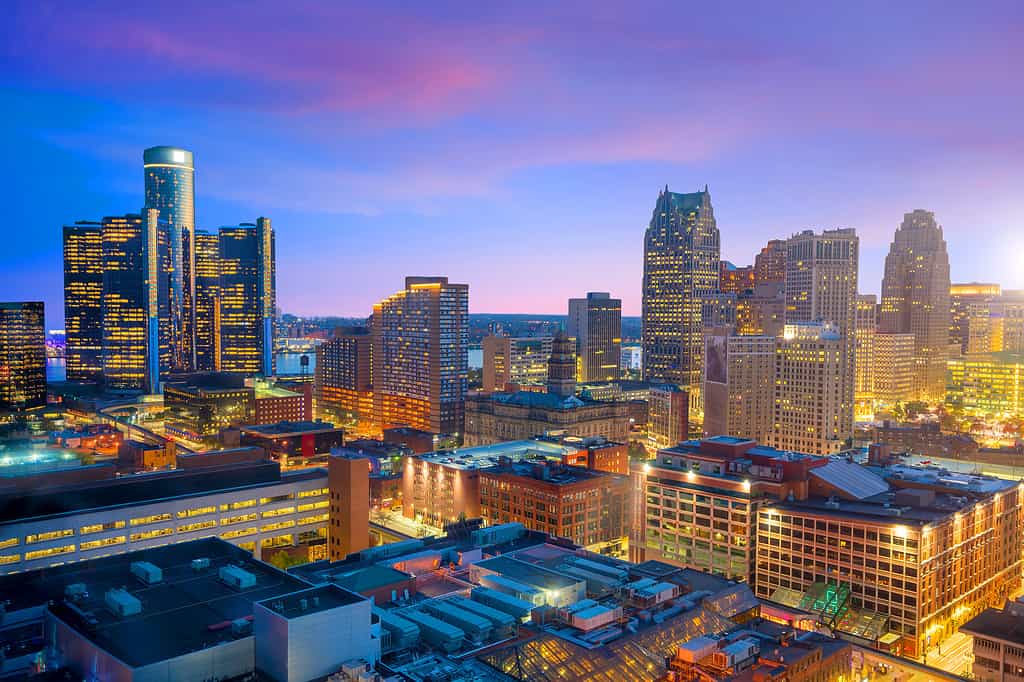
Detroit has the largest population of any city in Michigan.
©f11photo/Shutterstock.com
The largest city in Michigan and the 21st largest in the United States, Detroit has a population of 621,193. It is the most populous city on the Great Lakes and the seat of Wayne County. Detroit is known for its automotive industry, music culture, and sports teams. The city has a population density of 4,478 people per square mile and a median age of 35.2 years. The city’s population has declined by 0.9% since 2020, following decades of depopulation due to suburbanization and deindustrialization, being one of the primary cities in a region known as the Rust Belt.
2. Grand Rapids
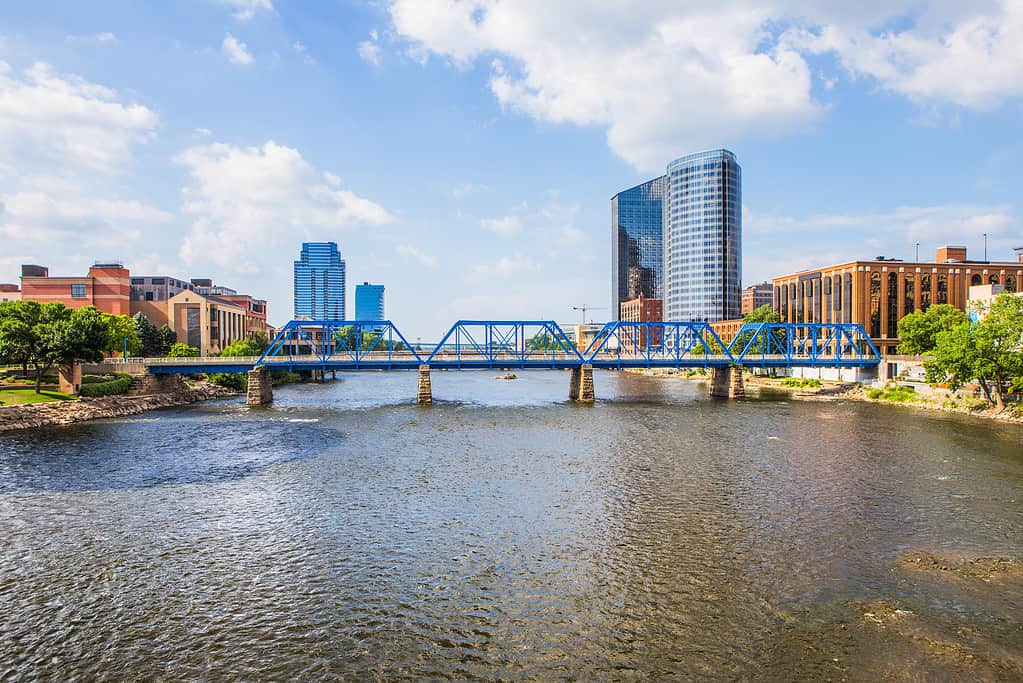
Grand Rapids is one of the state’s fastest-growing metropolitan areas.
©Suzanne Tucker/Shutterstock.com
The second-largest city in Michigan and the largest in West Michigan, Grand Rapids has a population of 195,911. It is the county seat of Kent County and a center of furniture manufacturing, health care, and education. The city has a population density of 4,377 people per square mile and a median age of 31.5 years. The city’s population declined by 0.38% since 2020, but it is still one of the state’s fastest-growing metropolitan areas.
3. Warren
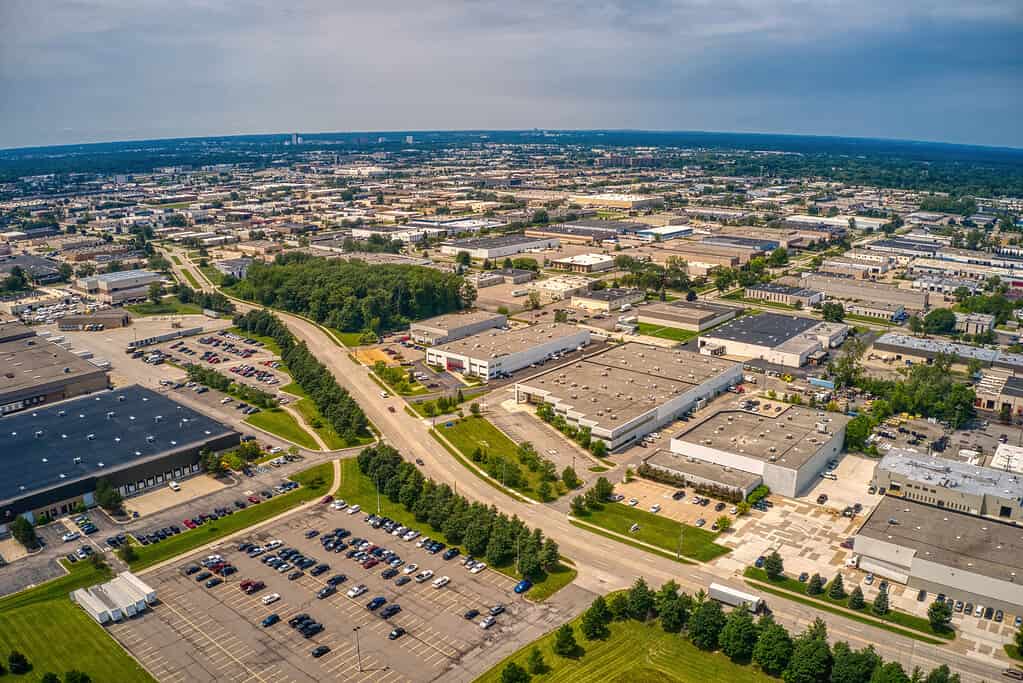
Warren is the biggest suburb of Detroit.
©Jacob Boomsma/iStock via Getty Images
The third-largest city in Michigan and the largest suburb of Detroit, Warren has a population of 136,153. It is the home of the General Motors Technical Center, the United States Army Detroit Arsenal, and several other automotive and defense-related companies. The city has a population density of 3,963 people per square mile and a median age of 40.7 years. The city’s population has declined by 0.72% since 2020, reflecting the overall trend of suburban decline in the Detroit metropolitan area.
4. Sterling Heights

Sterling Heights is one of the safest and most livable cities in the state by statistics.
©Tudoran Andrei/Shutterstock.com
The fourth-largest city in Michigan and the second largest suburb of Detroit, Sterling Heights has a population of 131,523. It is also part of Macomb County and a hub of automotive production, aerospace engineering, and ethnic diversity. The city has a population density of 3,610 people per square mile and a median age of 41.2 years. The city’s population has declined by 0.66% since 2020, but it remains one of the safest and most livable cities in the state by statistics.
5. Ann Arbor

Ann Arbor is best known for the University of Michigan.
©Better Planet Media/iStock via Getty Images
The fifth-largest city in Michigan and the seat of Washtenaw County, Ann Arbor has a population of 119,570. Ann Arbor is best known for the University of Michigan, one of the top colleges in the U.S. As a result, the surrounding area has a younger average age and an emphasis on art and culture, plus the college has created a high-tech economy and a progressive political sphere. The city has a population density of 4,284 people per square mile and a median age of 28 years. The city’s population has declined by 0.81% since 2020, but it is still one of the most educated cities in the state.
Summary of the Largest Cities in Michigan by Population
Here’s a recap of Michigan’s biggest cities by population size.
| Rank | City | Population |
|---|---|---|
| 1 | Detroit | 621,193 |
| 2 | Grand Rapids | 195,911 |
| 3 | Warren | 136,153 |
| 4 | Sterling Heights | 131,523 |
| 5 | Ann Arbor | 119,570 |
The Largest Cities in Michigan by Total Area
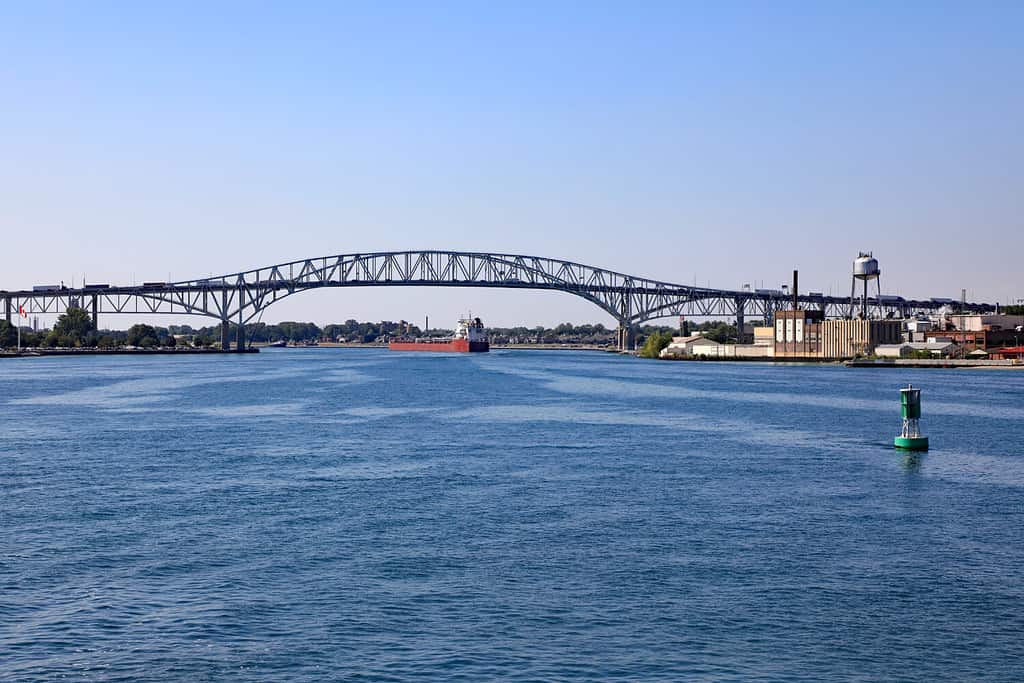
Detroit is once again the largest city in Michigan, this time by total land area.
©Thomas Barrat/Shutterstock.com
1. Detroit
The largest city in Michigan by area is Detroit, with a land area of 138.75 square miles. Detroit is located in the southeastern part of Michigan on Lake St. Clair and the Detroit River, directly west of the Canadian border. The city has a humid continental climate, with four distinct seasons and variable weather. Detroit is known for its urban parks, such as Belle Isle, Palmer Park, and Rouge Park. It also attracts visitors for its cultural attractions, such as the Detroit Institute of Arts, the Motown Museum, and the Henry Ford Museum.
2. Forest Hills
The second-largest city by land area is Forest Hills, with a land area of 49.27 square miles. Forest Hills is located directly east of Grand Rapids, about 50 miles from the shore of Lake Michigan. Forest Hills is known for its high quality of life, education, and income. The city has a humid continental climate, similar to Grand Rapids and Detroit. Forest Hills is known for its beauty, and its location puts it squarely in the rolling hills and forested regions of Michigan.
3. Grand Rapids
The third-largest city in Michigan by land area, Grand Rapids covers 44.4 square miles of land. It is located on the Grand River, about 30 miles east of Lake Michigan. Grand Rapids is known for its art scene, hosting the annual ArtPrize festival and featuring several museums and galleries. The city also has a humid continental climate, with cold winters and warm summers. Grand Rapids is known for its parks and trails, such as Millennium Park, Riverside Park, and the Fred Meijer White Pine Trail State Park.
4. Battle Creek
The fourth-largest city in Michigan by land area, Battle Creek covers 42.61 square miles of land. It is located on the Kalamazoo River and Battle Creek River in Calhoun County. Battle Creek is known for its cereal industry, being the headquarters of Kellogg Company and Post Consumer Brands. The city also has a humid continental climate, similar to other cities in Michigan. Battle Creek is known for its historical attractions, such as the Binder Park Zoo, the Kingman Museum, and the Underground Railroad Monument.
5. Sterling Heights
The fifth-largest city in Michigan by land area, Sterling Heights covers 36.51 square miles of land. It is located in Macomb County, north of Warren. Sterling Heights is known for its diversity, and the city hosts several festivals and events throughout the year. The city also has a humid continental climate, very similar to the other large cities across the state. Sterling Heights has a few notable parks and green spaces, including Dodge Park, Clinton River Park North, and Sterling Heights Nature Center.
Summary of the Largest Cities in Michigan by Total Area
These are Michigan’s top five biggest cities according to land size.
| Rank | City | Land Area |
|---|---|---|
| 1 | Detroit | 138.75 square miles |
| 2 | Forest Hills | 49.27 square miles |
| 3 | Grand Rapids | 44.4 square miles |
| 4 | Battle Creek | 42.61 square miles |
| 5 | Sterling Heights | 36.51 square miles |
The Largest Counties in Michigan by Economic Output
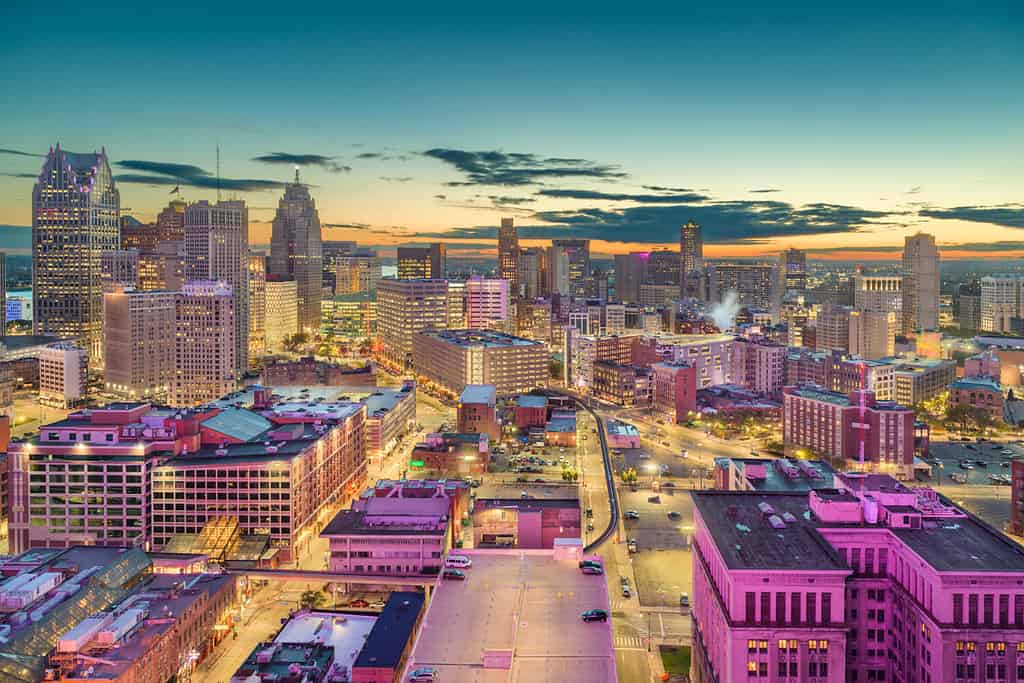
Oakland County and Wayne County top the list due to the impact of the Detroit greater metro area on the region.
©Sean Pavone/Shutterstock.com
Data on GDP by city is difficult to find. This section has been created using the GDP from counties, although we will note some of the major cities within each of the counties listed. The most recent data on GDP according to the metro area (city) was taken in 2017, rendering it somewhat inaccurate. The BEA (Bureau of Economic Analysis) released county data in 2021, much closer to today’s numbers.
1. Oakland County
The county with the highest GDP in Michigan is Oakland County, with a GDP of $100,384,284,000. The county is home to several major industries, including automotive, health care, finance, and technology. Some of the largest employers in the county are General Motors, Beaumont Health, FCA US, and Quicken Loans. Oakland County has also been a leader in innovation and entrepreneurship, with initiatives such as Automation Alley, Tech248, and Medical Main Street.
2. Wayne County
Wayne County is the largest county in Michigan by population and the second-largest by GDP, with a value of $89,501,989,000 in 2021. The county’s economy is dominated by the city of Detroit, which is the center of the American automotive industry and a hub for culture, sports, and entertainment. Some of the major employers in the county are Ford Motor Company, DTE Energy, Henry Ford Health System, and the City of Detroit. Wayne County has also seen a revival of its downtown and midtown areas, with new businesses, developments, and attractions being built in recent years.
3. Kent County
Kent County is the third-largest county in Michigan by GDP, with a value of $40,111,238,000 in 2021. The county’s economy is driven by the city of Grand Rapids, which is the second-largest city in the state and a regional hub for health care, education, manufacturing, and tourism. Some of the major employers in the county are Spectrum Health, Meijer, Amway, and Steelcase. Kent County has also been recognized as one of the best places to live and work in the country, with a high quality of life, a diverse population, and an arts and culture scene.
4. Macomb County
Macomb County is the fourth-largest county in Michigan by GDP, with a value of $37,532,821,000 in 2021. The county’s economy is heavily influenced by the automotive industry, with several major plants, suppliers, and research facilities located in the area. Some of the largest employers in the county are General Motors, Fiat Chrysler Automobiles, Ford Motor Company, and BAE Systems. Macomb County has also been a leader in defense and aerospace, with the Selfridge Air National Guard Base and the U.S. Army Tank Automotive Research, Development, and Engineering Center.
5. Washtenaw County
Washtenaw County is the fifth-largest county in Michigan by GDP, with a value of $23,859,602,000 in 2021. The county’s economy is anchored by the city of Ann Arbor, the home of the University of Michigan and a hub for innovation, research, and education. Some of the major employers in the county are the University of Michigan, Trinity Health, Toyota Motor Engineering & Manufacturing North America, and Domino’s Pizza. Washtenaw County has also been a hotspot for entrepreneurship and venture capital, with several startups, incubators, and accelerators based in the area. The county’s economy has shown resilience and growth during the COVID-19 pandemic, with a strong performance in sectors such as healthcare, technology, and professional services.
Summary of the Largest Counties in Michigan by Economic Output
Here are Michigan’s top five counties according to GDP data we found.
| Rank | County | GDP (in 2012 Chained Dollars) |
|---|---|---|
| 1 | Oakland County | $100,384,284,000 |
| 2 | Wayne County | $89,501,989,000 |
| 3 | Kent County | $40,111,238,000 |
| 4 | Macomb County | $37,532,821,000 |
| 5 | Washtenaw County | $23,859,602,000 |
Conclusion
Michigan has a lot to offer in terms of its cities, although a few major themes connect them all. When it comes to population, a few major cities have a majority of the population, with Detroit dominating. When it comes to size, Detroit once again comes in first, although the list remained somewhat the same as population showing us there is some correlation between them. Finally, when we look at GDP, we can see that Detroit has such an economic impact on the region that the two counties that it sits within are the two largest counties by GDP, without it being close. Still, other cities like Ann Arbor and Grand Rapids have a lot of pull and unique cultures due to the industries within (i.e., Michigan University and its impact on median age and technology in Ann Arbor).
Although Detroit dominates the state, there is a ton to see, do, and experience all over Michigan. It’s a state with a lot of natural beauty and plenty to enjoy.
The photo featured at the top of this post is © iStock.com/f11photo
Thank you for reading! Have some feedback for us? Contact the AZ Animals editorial team.







